Rating agency Crisil forecasts financial savings to rise to Rs 315 lakh crore, or 74 percent of the GDP by 2027, from Rs 135 lakh crore or 57 percent last fiscal.
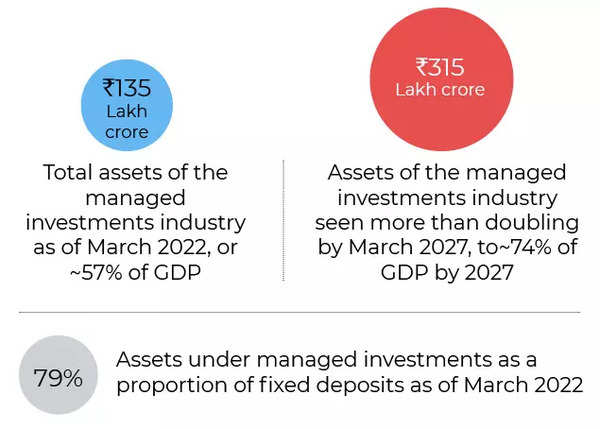
While bank fixed deposits remain the most preferred financial instrument in the country, their share has declined over the years, with investors moving towards capital market instruments.
Fixed income instruments, as seen in their penchant for bank fixed deposits, accounted for 41% of the household savings pie as of March 2022. Within the investment landscape, the share of equity has increased from 24% in fiscal 2017 to 31% in fiscal 2022 while the share of alternative products as represented by AIFs has grown from 1% to 5% in the past five years.
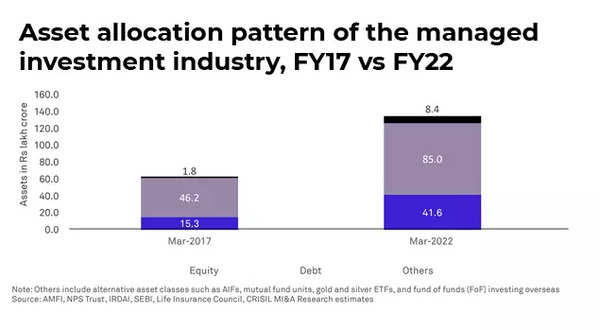
Assets of the managed investments industry in India have more than doubled in five years, from just Rs 63 lakh crore in March 2017 to Rs 135 lakh crore in March 2022. By quantum, assets of mutual funds and insurers leapt Rs 20 lakh crore each.
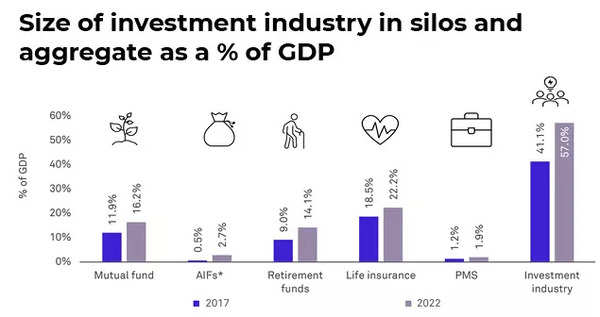
“As of last fiscal, AUM of the managed funds industry amounted to 57% of India’s gross domestic product,” said Ashish Vora, President & Head, CRISIL Market Intelligence & Analytics. “In the next five years, we see this proportion rising to 74% as financialisation increases. Much has happened in the investment landscape over the past five fiscals, yet the industry has barely scratched the surface given the potential in different categories and compared with how such assets have grown in the developed countries.”
Household savings comprised over two-thirds of India’s gross savings except for the pandemic period when it shot up to 78% touching Rs 43.9 lakh crore.
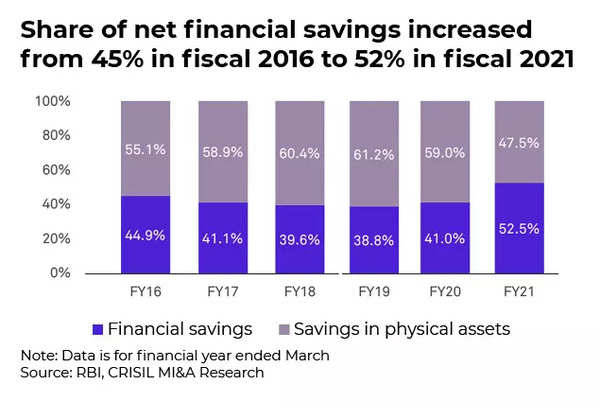
Directed efforts at financial inclusion, digitalisation, a longerterm trend of rising middle-class disposable incomes, and government incentives on these instruments, have better channelled these savings to the industry. With rising inflation, households too, are seeking higher returns beyond fixed deposits.
Life insurance companies comprised the biggest chunk of managed investments with a 39% market share at Rs 52 lakh crore. Mutual funds with assets under management of Rs 28 lakh crore and a market share of over 28% came next, the Crisil study showed. Though these still represent only 10% of households’ gross financial savings, they have gained from a big shift out of bank deposits.
CRISIL MI&A estimates the industry to grow to Rs 315 lakh crore in the next five years. And this growth will be led by a mix of macro and segment-specific factors.
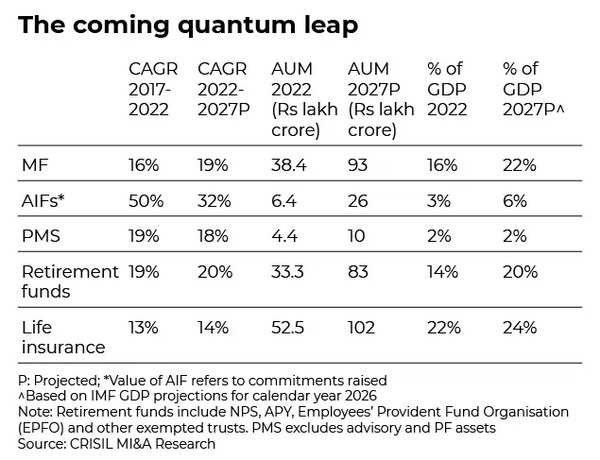
Strong GDP growth
CRISIL MI&A Research expects India to regain its tag of one of the fastest-growing economies globally in the medium term. The IMF has also forecast that the country’s GDP will grow at a faster pace compared with other economies.
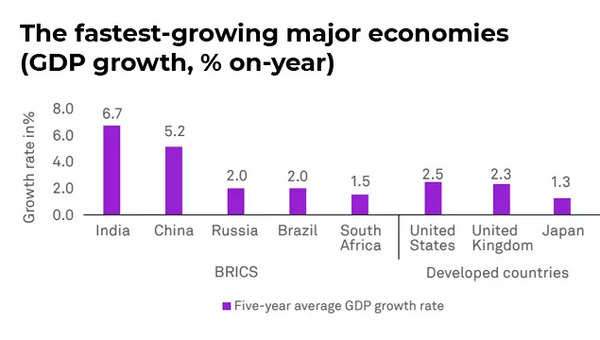
Per-capita income surpasses inflection point
India’s per-capita income crossed the $2,000 threshold in 2021, i.e., the inflection point when income crosses the subsistence expenditure level and moves on to spending and investments. India’s per-capita income expanded 7.6% last fiscal.
“High per-capita income, prospects of strong economic growth, financialisation of household savings, emergence of technology, and access to capital market products provide a fillip to the investment climate in the country,” said Crisil.
Rising middle-income population and demographic dividend
An estimated 83% of households in India had an annual income of less than Rs 2 lakh in fiscal 2012. That number reduced to 76% in fiscal 2017, and is expected to touch 65% this fiscal owing to the continuous increase in GDP and household incomes. The proportion of middle-income India — defined as households with annual income between Rs 2 lakh and Rs 10 lakh — has been rising over the past decade. CRISIL MI&A Research estimates there were 4.1 crore households in India in this category in fiscal 2012. By fiscal 2030, these are projected to reach 18.1 crore.That’s around 1.5 times the number of households (12.4 crore) in the US as of 2021.
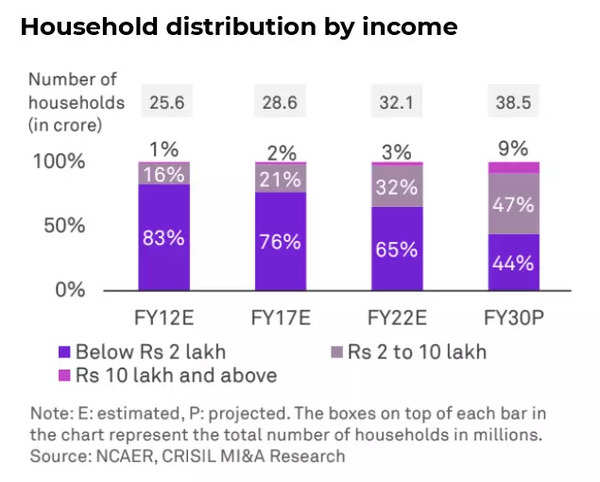
As per United Nations population projections, about 94 crore people, or 67% of India’s population, currently belong to the working age group of 15- 64 years. This cohort will increase by 10 crore over the next decade, despite declining birth rate.” Indeed, over the next decade, more than a fifth (22.5%) of the incremental global workforce will come from India,” said Crisil.
What is improving the financialisation of savings rate of Indian households?
India’s financial inclusion improved significantly over 2014-21 — the share of adult population with a bank account increased from 53% to 78% on the back of government measures and proliferation of supporting institutions.
This is improving the financialisation of savings rate of Indian households, which is one of the highest in the world. At end-2021, the domestic savings rate of 29.3% was higher than the global average of 26.9%.
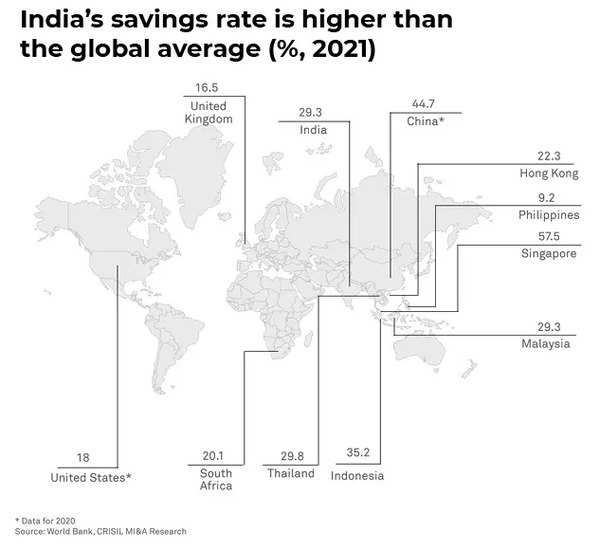
According to the RBI, the share of financial savings increased from 45% in fiscal 2016 to 52% in fiscal 2021, while that of physical savings fell from 55% to 48%.
The money getting financialised is increasingly being invested in mutual funds and insurance funds. The share of mutual funds has increased from 7% in June 2018 to nearly 10% in March 2022, while the share of insurance funds has risen from 20% to 24% during the same period.
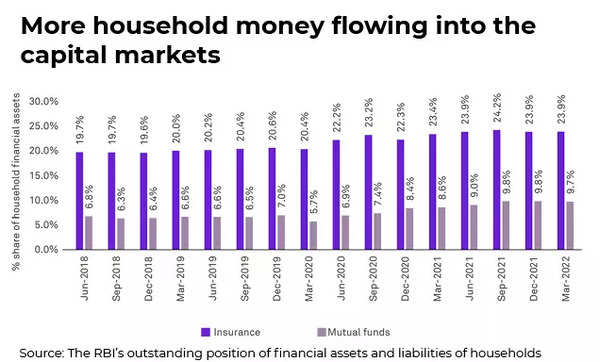
A case in point is the proliferation of SIP accounts to 6 crore as of October 2022, up 66 lakh accounts since the start of this fiscal.
“The ratio of new SIP accounts opened to those closed also remains healthy, at about 2.4:1. Assets under SIPs crossed Rs 6.5 lakh crore as of October 2022, taking their share to nearly 17% of the overall industry AUM. Further, this flow of money into MFs has been growing despite market volatility. SIP investments have increased from a mere Rs 3,000 crore as of April 2016 to over Rs 13,000 crore as of October 2022,” noted the study.
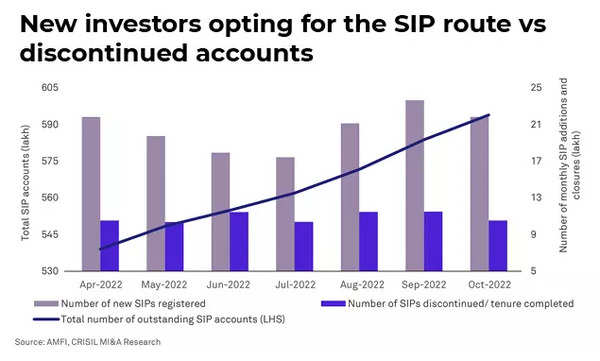
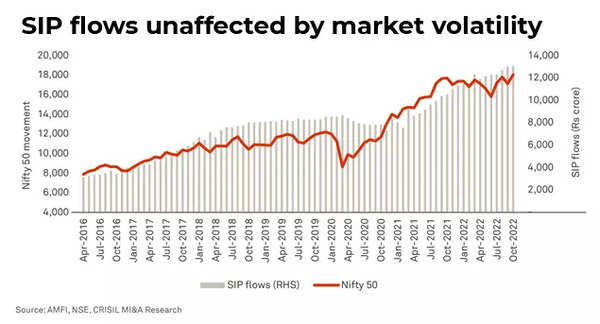
Even the maturity horizon among investors holding funds for more than two years has increased to 43% as of March 2022 from 38 percent five years ago.
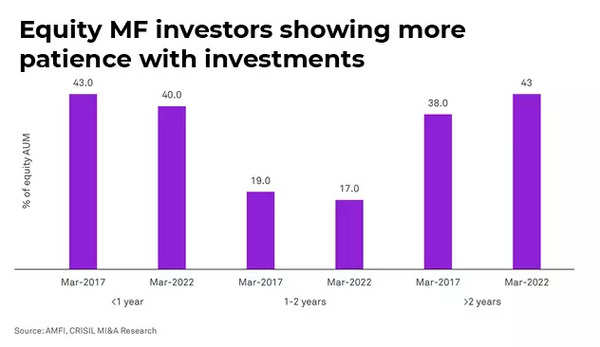
Formal sector driving retirement funds growth
The formalisation of the economy will be an important growth driver of the retirement fund industry as it brings individuals within the mainstream segment of the financial landscape. Subscribers from central government, state government and provident funds, which contribute mandatorily towards the retirement corpus, make up for 7.6 crore individuals. Voluntary contribution schemes such as NPS (corporate and unorganised sector), Atal Pension Yojana (APY), and Swavalamban have 4.4 crore individual subscribers.
The total number of accounts from these schemes is around 12 crore, compared with a working-age population of 94 crore individuals in the country.
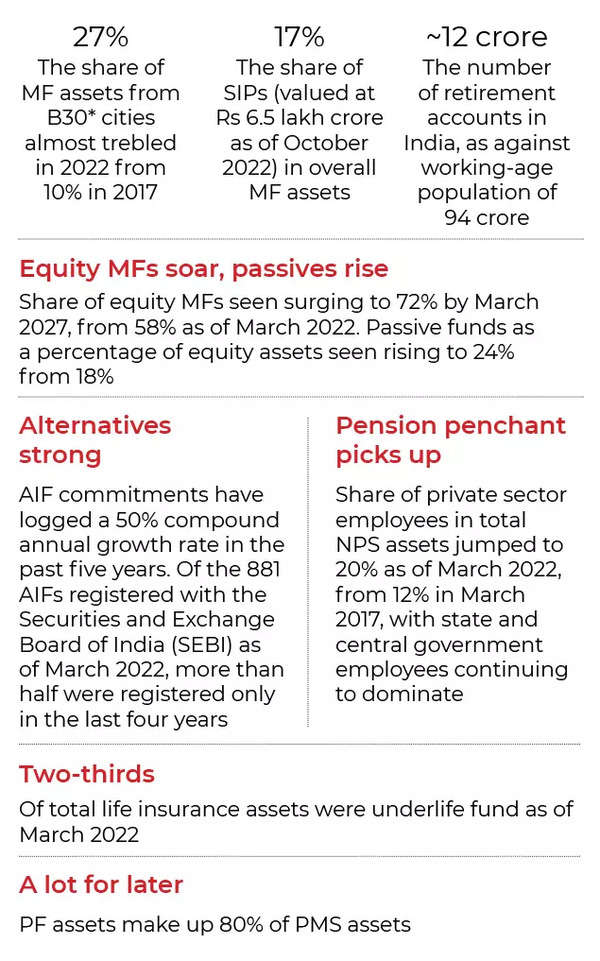
!(function(f, b, e, v, n, t, s) {
window.TimesApps = window.TimesApps || {};
const { TimesApps } = window;
TimesApps.loadFBEvents = function() {
(function(f, b, e, v, n, t, s) {
if (f.fbq) return;
n = f.fbq = function() {
n.callMethod ? n.callMethod(…arguments) : n.queue.push(arguments);
};
if (!f._fbq) f._fbq = n;
n.push = n;
n.loaded = !0;
n.version = ‘2.0’;
n.queue = [];
t = b.createElement(e);
t.async = !0;
t.src = v;
s = b.getElementsByTagName(e)[0];
s.parentNode.insertBefore(t, s);
})(f, b, e, v, n, t, s);
fbq(‘init’, ‘593671331875494’);
fbq(‘track’, ‘PageView’);
};
})(
window,
document,
‘script’,
‘https://connect.facebook.net/en_US/fbevents.js’,
);if(typeof window !== ‘undefined’) {
window.TimesApps = window.TimesApps || {};
const { TimesApps } = window;
TimesApps.loadScriptsOnceAdsReady = () => {
var scripts = [
‘https://static.clmbtech.com/ad/commons/js/2658/toi/colombia_v2.js’ ,
‘https://www.googletagmanager.com/gtag/js?id=AW-877820074’,
‘https://www.googletagmanager.com/gtag/js?id=AW-658129294’,
‘https://imasdk.googleapis.com/js/sdkloader/ima3.js’,
‘https://tvid.in/sdk/loader.js’,
‘https://timesofindia.indiatimes.com/video_comscore_api/version-3.cms’,
‘https://timesofindia.indiatimes.com/grxpushnotification_js/minify-1,version-2.cms’,
‘https://connect.facebook.net/en_US/sdk.js#version=v10.0&xfbml=true’,
‘https://timesofindia.indiatimes.com/locateservice_js/minify-1,version-14.cms’
];
scripts.forEach(function(url) {
let script = document.createElement(‘script’);
script.type=”text/javascript”;
if(!false && !false && !false && url.indexOf(‘colombia_v2’)!== -1){
script.src = url;
} else if (!false && !false && !false && url.indexOf(‘sdkloader’)!== -1) {
script.src = url;
} else if (!false && !false && (url.indexOf(‘tvid.in/sdk’) !== -1 || url.indexOf(‘connect.facebook.net’) !== -1 || url.indexOf(‘locateservice_js’) !== -1 )) {
script.src = url;
} else if (url.indexOf(‘colombia_v2’)== -1 && url.indexOf(‘sdkloader’)== -1 && url.indexOf(‘tvid.in/sdk’)== -1 && url.indexOf(‘connect.facebook.net’) == -1){
script.src = url;
}
script.async = true;
document.body.appendChild(script);
});
}
}







More News
India received over $111 billion in remittances in 2022, first country to ever reach that figure: UN – Times of India
Air India Express cancels 70 flights after crew members go on ‘mass sick leave’ – Times of India
Stock market today: BSE Sensex slips 250 points; Nifty50 near 22,200 – Times of India